
 Plynlimon or what?
Plynlimon or what?
Tony & Jeff visit the sources of the Wye and Severn
At last the day had arrived. After over a year of planning and delays caused by the Foot and Mouth crisis, September 15th 2001 had been chosen as the date for implementation. Planning had been a daunting task involving several Saturday lunches at the Aroon Rai Thai restaurant in Hereford, preceded and followed by sampling the offerings of various local pubs. There were three objectives for our expedition: to visit the sources of the rivers Wye and Severn and, if possible, the site of the battle of Hyddgen where Owain Glyndwr defeated an English army in 1401. The connection? - Plynlimon (Pumlumon), a range of hills in mid Wales which runs SW to NE, with maybe 10 'peaks' up to 2500 feet in height. The Wye and Severn, which join south of Chepstow just before entering the Severn Estuary, have their sources just 2 miles apart on Plynlimon.
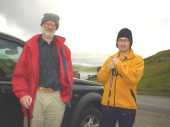 We (Jeff Jones and Tony Scott) stayed at the George Borrow Hotel at Ponterwyd the night before, an excellent base for our venture, and practised our navigation skills by finding a (the?) Chinese restaurant in Aberystwyth. We kicked off our day's journey by driving up the road to the Nant-y-Moch reservoir. This was formed in 1961 by damming the rivers Hengwm, Llechwedd-mawr and Rheidol. Pausing to look at the memorial plaque marking Owain Glyndwr's victory which is in the car park by the dam, we continued up the track to a point [SN 76800 87400]
We (Jeff Jones and Tony Scott) stayed at the George Borrow Hotel at Ponterwyd the night before, an excellent base for our venture, and practised our navigation skills by finding a (the?) Chinese restaurant in Aberystwyth. We kicked off our day's journey by driving up the road to the Nant-y-Moch reservoir. This was formed in 1961 by damming the rivers Hengwm, Llechwedd-mawr and Rheidol. Pausing to look at the memorial plaque marking Owain Glyndwr's victory which is in the car park by the dam, we continued up the track to a point [SN 76800 87400]  where a rough (but driveable with the right vehicle) track leads off up hill about ½ mile before the Maesnant outdoor centre. Parking the car, we set off up the track at 10.15. The track ended at the impressive lake Llyn Llygad Rheidol [SN 79100 87900], the source of the Rheidol, and the Aberystwth water supply, which we reached at about 12.00. On the way we had a good view of the Hyddgen valley (Cwm Hyddgen), which was where Owain's battle took place, and decided we were able to identify at least one of the 'standing stones' (unhewn calcite blocks, the Glyndwr covenant stones) which mark the site of the battle. After a pause for photographs (Tony had brought a tripod as well as his digital camera, so we were able to capture both of us) we took off up the hill to the right hand side of the lake.
where a rough (but driveable with the right vehicle) track leads off up hill about ½ mile before the Maesnant outdoor centre. Parking the car, we set off up the track at 10.15. The track ended at the impressive lake Llyn Llygad Rheidol [SN 79100 87900], the source of the Rheidol, and the Aberystwth water supply, which we reached at about 12.00. On the way we had a good view of the Hyddgen valley (Cwm Hyddgen), which was where Owain's battle took place, and decided we were able to identify at least one of the 'standing stones' (unhewn calcite blocks, the Glyndwr covenant stones) which mark the site of the battle. After a pause for photographs (Tony had brought a tripod as well as his digital camera, so we were able to capture both of us) we took off up the hill to the right hand side of the lake.
With the help of the map, 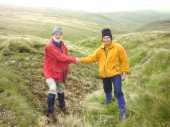 some guidance from a book called 'Best Fifty Walks of Britain' and a GPS navigation tool, we were able to locate the source of the River Wye (Afon Gwy) [SN 80100 87050] at 14.15. This was more like the source of a river than we had thought (a boggy puddle was what we had expected) but was dry. After the inevitable photo shoot we donned our wet weather gear as it seemed it was starting to rain (it then stopped!)
some guidance from a book called 'Best Fifty Walks of Britain' and a GPS navigation tool, we were able to locate the source of the River Wye (Afon Gwy) [SN 80100 87050] at 14.15. This was more like the source of a river than we had thought (a boggy puddle was what we had expected) but was dry. After the inevitable photo shoot we donned our wet weather gear as it seemed it was starting to rain (it then stopped!) 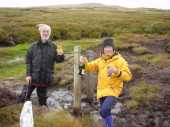 and headed off towards our next objective, the source of the River Severn (Afon Hafren) [SN 82200 89900]. At about 16.30 we reached this via the summit of Pen Pumlumon Arwystli [SN 81500 87800] with its cairns. Here we did find our boggy puddle - well a large area of boggy ground in one part of which was a stake marking the river's source. Why this particular spot was marked as the source wasn't apparent to us. The Severn valley walk extends to the source, and the route is marked with stakes. At this point Tony produced the big surprise - a bottle of champagne with which we celebrated our achievement. It had been a heavy load to carry on the ascent but made our descent, at least initially, light work.
and headed off towards our next objective, the source of the River Severn (Afon Hafren) [SN 82200 89900]. At about 16.30 we reached this via the summit of Pen Pumlumon Arwystli [SN 81500 87800] with its cairns. Here we did find our boggy puddle - well a large area of boggy ground in one part of which was a stake marking the river's source. Why this particular spot was marked as the source wasn't apparent to us. The Severn valley walk extends to the source, and the route is marked with stakes. At this point Tony produced the big surprise - a bottle of champagne with which we celebrated our achievement. It had been a heavy load to carry on the ascent but made our descent, at least initially, light work.
Deciding on a different route back which would complete a circular journey, we set off towards the West on the hardest part of our trek. Although most of this was down hill or level, the ground was uneven and boggy, much of it covered with tussocks of grass, and the going wasn't easy. We picked our time to descend to the banks of the Hengwm, having to pick a crossing  place over another river (the Gwerin) which joined it. Passing a derelict farmhouse [SN 79750 89350] we followed the river bank to a point where we joined a track which took us back to our start point. It took us about 3 hours to get back to our start point from the source of the Severn - we reached the car just before 20.00. Towards the end of our journey we once again had a good view of the Hyddgen valley and were able to confirm that we had indeed seen the standing stones, as sheep wouldn't have stayed still that long. Just before this we had passed a small bridge [SN 78450 89200] over the Hengwm which we could have used to get to the Hyddgen valley if time had allowed - maybe another visit?
place over another river (the Gwerin) which joined it. Passing a derelict farmhouse [SN 79750 89350] we followed the river bank to a point where we joined a track which took us back to our start point. It took us about 3 hours to get back to our start point from the source of the Severn - we reached the car just before 20.00. Towards the end of our journey we once again had a good view of the Hyddgen valley and were able to confirm that we had indeed seen the standing stones, as sheep wouldn't have stayed still that long. Just before this we had passed a small bridge [SN 78450 89200] over the Hengwm which we could have used to get to the Hyddgen valley if time had allowed - maybe another visit?
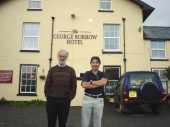 Back at the hotel by about 20.30 we celebrated our success with a curry, a few? drinks and, in Tony's case, singing the night away. George Borrow (author of 'Wild Wales') stayed at the 'Inn of Ponterwyd' in 1854. He also made the journey to the source of the Wye. As we looked at his life mask hanging on the wall of the bar we felt we were in good company.
Back at the hotel by about 20.30 we celebrated our success with a curry, a few? drinks and, in Tony's case, singing the night away. George Borrow (author of 'Wild Wales') stayed at the 'Inn of Ponterwyd' in 1854. He also made the journey to the source of the Wye. As we looked at his life mask hanging on the wall of the bar we felt we were in good company.
.
Next objective - the source of the Mersey perhaps?
To Email Jeff or Tony click on one of the photos below
It can't really be all the way up there?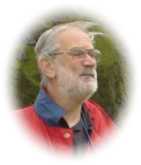

.
.
.
.
.
He'll be all right once he's had some of my Kendal Mint Cake